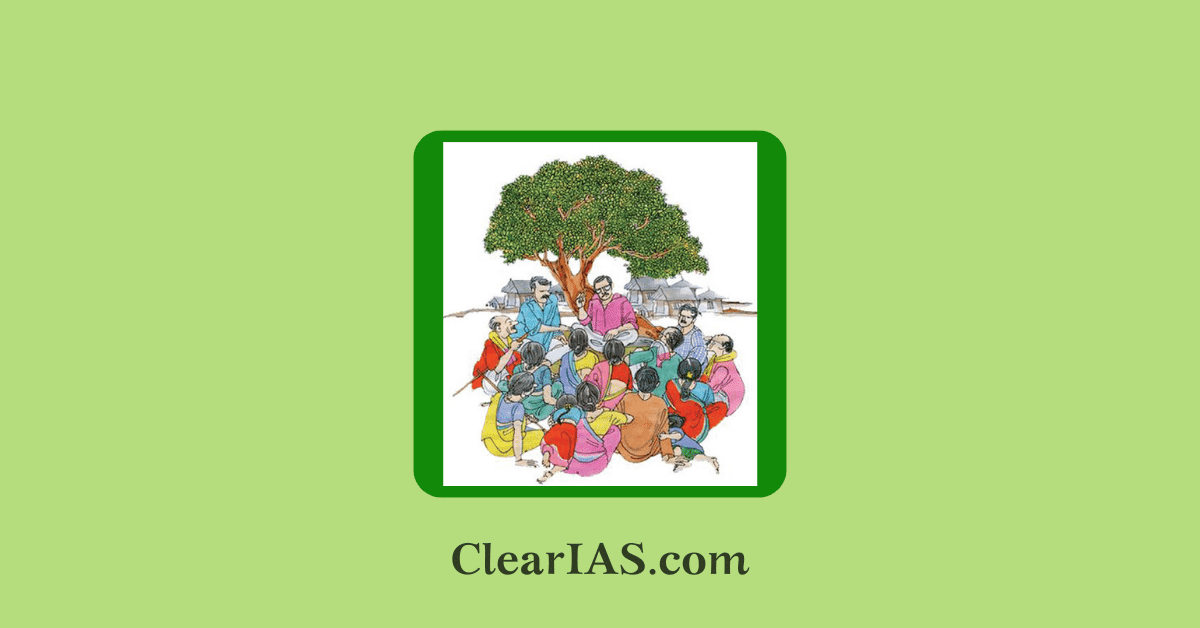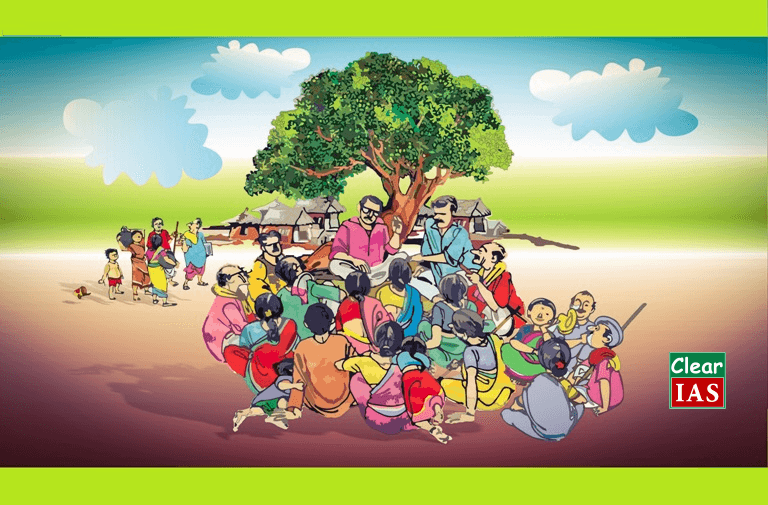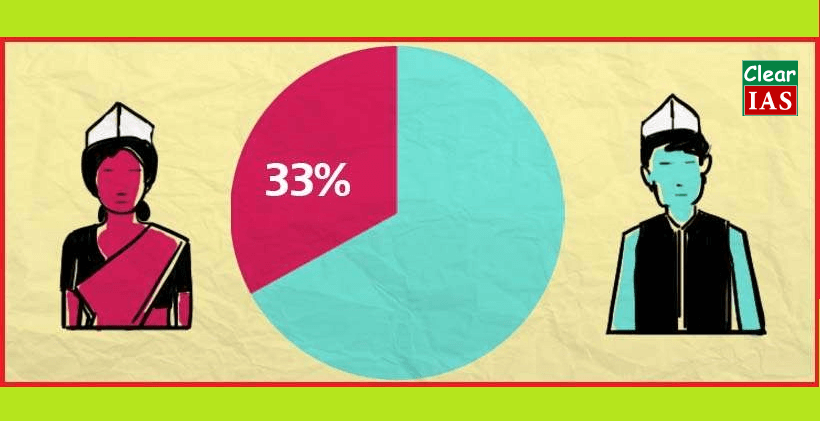
The Panchayati Raj system is a vital component of India’s democratic governance, allowing citizens to participate in decision-making at the local level and contributing to the country’s rural development and grassroots democracy. Read here to learn more about the system.
We know there is a government in India at the Center and State levels. But there is another important system for local governance. The foundation of the present local self-government in India was laid by the Panchayati Raj System (1992).
But the history of Panchayati Raj starts from the self-sufficient and self-governing village communities. In the time of the Rig-Veda (1700 BC), evidence suggests that self-governing village bodies called ‘sabhas’ existed. With time, these bodies became panchayats (councils of five persons).
Panchayats were functional institutions of grassroots governance in almost every village. They endured the rise and fall of empires in the past, to the current highly structured system.
Also read: Punchhi Commission Report
What is the Panchayati Raj System?
The Panchayati Raj system in India is a decentralized form of government that aims to bring governance closer to the grassroots level by establishing elected local self-government institutions in rural areas.
The term “Panchayati Raj” literally translates to “rule by the five,” where “panch” means “five” and “raj” means “rule.” These institutions play a vital role in local governance, rural development, and participatory democracy.
The Panchayati Raj system in India is organized into a three-tier structure, comprising:
- Gram Panchayat (Village Level): This is the lowest tier and represents a single village or a group of villages. It is the basic unit of the Panchayati Raj system.
- Panchayat Samiti (Block/Mandal Level): The Panchayat Samiti is the intermediate tier that covers a block or a mandal, which typically consists of several villages.
- Zila Parishad (District Level): At the top of the hierarchy is the Zila Parishad, which covers an entire district. It coordinates and supervises the activities of the lower tiers.
History of local administration
The history of local administration in India is a long and diverse one, shaped by the evolution of political, cultural, and administrative systems over millennia. India has a rich tradition of local governance dating back to ancient times, and this system has evolved through various dynasties, empires, and colonial periods.
Ancient Period:
- In ancient India, the political landscape was divided into numerous Janapadas, or small kingdoms and republics. These Janapadas had their systems of local governance, with councils and assemblies known as “Sabhas” and “Samitis” that handled administrative and judicial matters.
- Under the Mauryan Empire (322-185 BCE), Emperor Ashoka established a system of local administration with officials known as “Mahamatras” responsible for the welfare of the people in various regions. He also inscribed edicts on pillars and rocks to communicate his policies to the local population.
Medieval Period:
- Feudal System: During the medieval period, India experienced the emergence of feudalism. Feudal lords and local chieftains governed their territories with varying degrees of autonomy. The Delhi Sultanate and later the Mughal Empire introduced the system of “jagirs” or land grants to nobles in exchange for revenue collection and military service.
- Local Chiefs and Rajas: Regional rulers, such as Rajas and Zamindars, exercised local authority and governed their territories independently, often collecting revenue from peasants.
Colonial Period:
- The British East India Company and later the British Crown introduced a centralized administrative system that significantly altered local governance. They established a revenue collection system, where land revenue was collected directly from peasants or through intermediaries known as zamindars.
- The British also introduced local self-government institutions such as municipalities and panchayats. The Montagu-Chelmsford Reforms (1919) and the Government of India Act (1935) allowed for some degree of local representation in governance.
The village panchayat, as a system of administration, began in the British days, as their offer to satisfy the demands for local autonomy.
They opened up the governance of the lowest levels to the citizens. The GoI Act, of 1935 also authorizes the provinces to enact legislation.
Evolution of local self-government in India
Even though such minor forms of local governance were evident in India, the framers of the constitutions, unsatisfied with the existing provisions, included Article 40 among the Directive Principles, whereby:
“The state shall take steps to organize village panchayats and endow them with such powers and authority as may be necessary to enable them to function as units of self-government.”
Later, the conceptualization of the system of local self-government in India took place through the formation and effort of four important committees from the year 1957 to 1986. It will be helpful if we take a look at the committee and the important recommendations put forward by them.
Balwant Rai Mehta Committee (1957)
Originally appointed by the Government of India to examine the working of two of its earlier programs, the committee submitted its report in November 1957, in which the term ‘democratic decentralization‘ first appears.
The important recommendations are:
- Establishment of a three-tier Panchayati Raj system – gram panchayat at the village level (direct election), panchayat Samiti at the block level, and Zila Parishad at the district level (indirect election).
- District Collector to be the chairman of Zila Parishad.
- Transfer of resources and power to these bodies to be ensured.
The existing National Development Council accepted the recommendations. However, it did not insist on a single, definite pattern to be followed in the establishment of these institutions. Rather, it allowed the states to devise their patterns, while the broad fundamentals were to be the same throughout the country.
Rajasthan (1959) adopted the system first, followed by Andhra Pradesh in the same year. Some states even went ahead to create four-tier systems and Nyaya panchayats, which served as judicial bodies.
Ashok Mehta Committee (1977-1978)
The committee was constituted by the Janata government of the time to study Panchayati Raj institutions. Out of a total of 132 recommendations made by it, the most important ones are:
- Three-tier system to be replaced by a two-tier system.
- Political parties should participate at all levels in the elections.
- Compulsory powers of taxation are to be given to these institutions.
- Zila Parishad is to be made responsible for planning at the state level.
- A minister for Panchayati Raj is to be appointed by the state council of ministers.
- Constitutional recognition to be given to Panchayati Raj institutions.
Unfortunately, the Janata government collapsed before action could be taken on these recommendations.
G V K Rao Commitee (1985)
Appointed by the Planning Commission, the committee concluded that the developmental procedures were gradually being taken away from the local self-government institutions, resulting in a system comparable to ‘grass without roots’.
- Zila Parishad is to be given prime importance and all developmental programs at that level are to be handed to it.
- Post of DDC (District Development Commissioner) to be created acting as the chief executive officer of the Zila Parishad.
- Regular elections are to be held
L M Singhvi Committee (1986)
Constituted by the Rajiv Gandhi government on ‘Revitalisation of Panchayati Raj institutions for Democracy and Development, its important recommendations are:
- Constitutional recognition for PRI institutions.
- Nyaya Panchayats to be established for clusters of villages
Though the 64th Constitutional Amendment bill was introduced in the Lok Sabha in 1989 itself, the Rajya Sabha opposed it. It was only during the Narasimha Rao government’s term that the idea finally became a reality in the form of the 73rd and 74th Constitutional Amendment Acts, of 1992.
Panchayati Raj System: 73rd and 74th Constitutional Amendment acts, 1992
The acts of 1992 added two new parts IX and IX-A to the constitution. It also added two new schedules – 11 and 12 which contain the lists of functional items of Panchayats and Municipalities.
It provides for a three-tier system of Panchayati Raj in every state – at the village, intermediate, and district levels.
Read: Panchayati Raj
What are Panchayats and Municipalities?

- Panchayat and Municipality are the generic terms for the governing body at the local level. Both exist as three-tier systems – at the lower, intermediate, and upper levels.
- The 73rd Constitutional Amendment Act provides for a Gram Sabha as the foundation of the Panchayati Raj system. It is essentially a village assembly consisting of all the registered voters in the area of the panchayat. The state has the power to determine what kind of powers it can exercise, and what functions it has to perform at the village level.
- The 74th Constitutional Amendment Act provides for three types of Municipalities:
- Nagar Panchayat for a transitional area between a rural and urban area.
- Municipal Council for a small urban area.
- Municipal Corporation for a large urban area.
- Municipalities represent urban local self-government.
- Most of the provisions of the two acts are parallel, differing only in the fact that they are being applied to either a Panchayat or a Municipality respectively.
- Each Gram sabha is the meeting of a particular constituency called a ward.
- Each ward has a representative chosen from among the people themselves by direct election.
- The chairperson of the Panchayat or Municipality at the intermediate and district level is elected from among these representatives at the immediately lower level by indirect election.
Types of Urban Local Self-Governments
There are eight types of urban local governments currently existing in India:
- Municipal Corporations.
- Municipality.
- Notified area committee.
- Town area committee.
- Cantonment board.
- Township.
- Port trust.
- Special purpose agency
How are the elections held in the local government bodies?

- All seats of representatives of local bodies are filled by people chosen through direct elections.
- The conduct of elections is vested in the hands of the State election commission.
- The chairpersons at the intermediate and district levels shall be elected indirectly from among the elected representatives at the immediately lower level.
- At the lowest level, the chairperson shall be elected in a mode defined by the state legislature.
- Seats are reserved for SC and ST proportional to their population.
- Out of these reserved seats, not less than one-third shall be further reserved for women.
- There should be a blanket reservation of one-third of seats for women in all the constituencies taken together too (which can include the already reserved seats for SC and ST).
- The acts bar the interference of courts in any issue relating to the election of local bodies.
What are the Qualifications needed to be a member of the Panchayat or Municipality?
Any person who is qualified to be a member of the state legislature is eligible to be a member of the Panchayat or Municipality.
“But he shall not be disqualified on the ground that he is less than 25 years of age if he has attained the age of 21 years”
This means that, unlike the state legislature, a person needs to attain only 21 years of age to be a member of a panchayat/municipality.
What is the duration of the Local Government bodies?
- The local governing bodies are elected for a term of five years.
- Fresh elections should be conducted before the expiry of the five-year term.
- If the panchayat/municipality is dissolved before the expiry of its term, elections shall be conducted within six months and the new panchayat/municipality will hold office for the remainder of the term if the term has more than six months duration.
- And for another five years if the remaining term is less than six months.
What are the Powers invested in these Local Self-Government bodies?
The powers of local bodies are not exclusively defined. They can be tailor-fitted by the state governments according to the environment of the states. In general, the State governments can assign powers to Panchayats and Municipalities that may enable them to prepare plans for economic development and social justice. They may also be authorized to levy, collect, or appropriate taxes.
Summary
To conclude, local self-government is one of the most innovative governance change processes our country has gone through. The noble idea of taking the government of a country into the hands of the grassroots level is indeed praiseworthy.
However, like any system in the world, this system is also imperfect. Problems of maladministration and misappropriation of funds are recurring. But this shall not stand in the way of efficient governance; and if these ill practices are rooted out, there would be no comparisons around the world to our system of local self-government.
Read: Finances of Panchayati Raj institutions
Article by: Unnikrishna Varma






Amazing wonderful info about 73rd nd 74th article excellent
thanku sir excellent…….
helpful post….. thank you ClearIAS for easing aspirant’s job. 🙂
Excellent sir
easy and useful
Nice one
The way it describes itself is easy to remember.
Easy way to get the knowledge and remember . excellent work .
very very nice
Thank you, very nice
Please explain further about the need for a three-tiered system of governance at lower levels viz lower intermediate and higher
Also explain about the need for various types in urban bodiesviz.,municipality, municipal corporation, port trustetc,.-
thanks
Super nd detailed information thnx
Is a gram sabha(formed by one or more villages according to its population) and gram panchayat same? or do we have a gram panchayat for each village irrespective of the number of villages in the gram sabha
gram sabha is same
Total number of electors are the member of gram sabha.
why panchayati raj system is partyless
Interesting and easy sir
where are thungon commitee and gadgil commitee
How many part of local govt in india
greatly defined in brief.
Can somebody enlighten me by telling when and where did the first Panchayat Elections took place?
Ashok Mehta Committee recommended “a two-tier system” not “three-tier system”. Please edit the info.
Nice sir useful to write my civics project
Very useful and impotant information…many many thanks for this …
Very useful information and content thanks a lot..